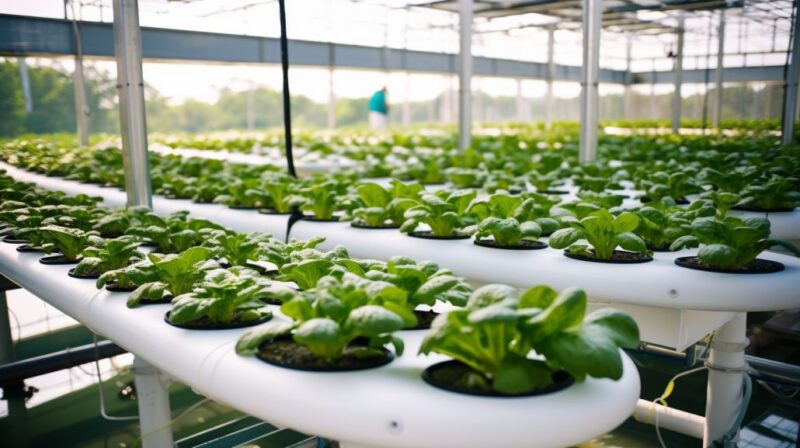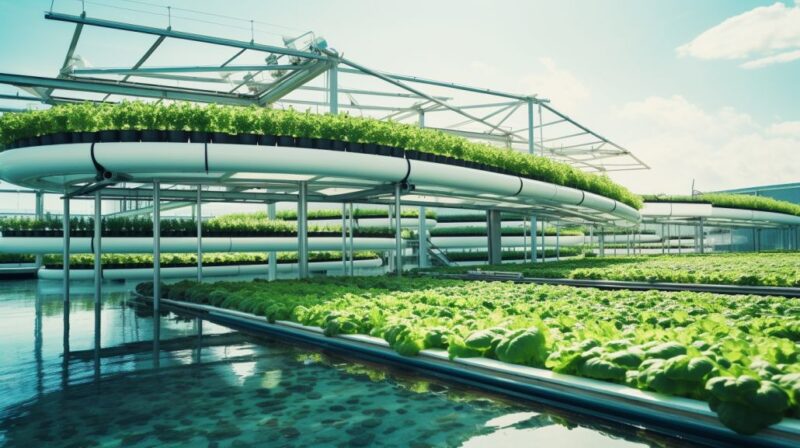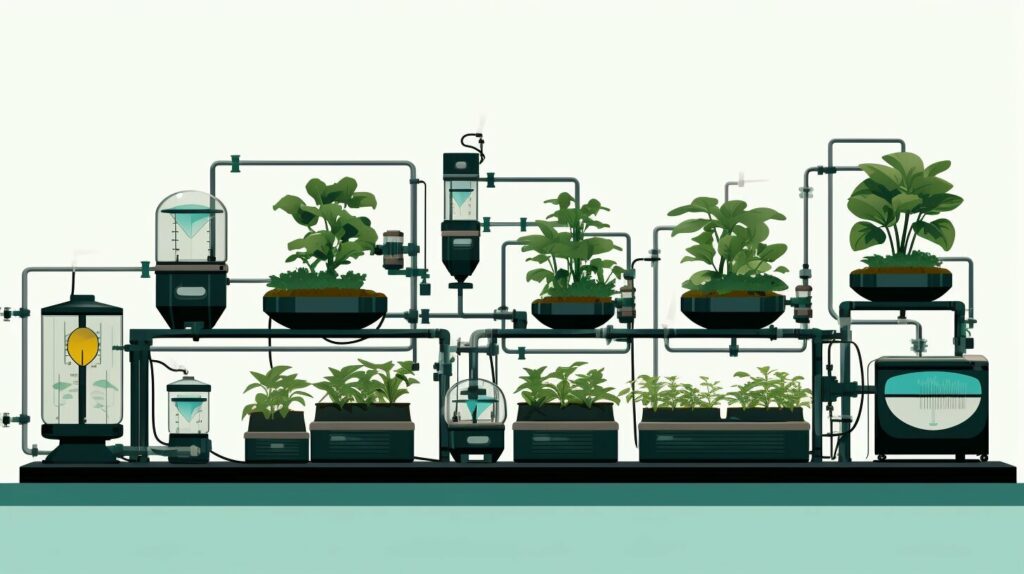This post may contain affiliate links and we may earn a small commission when you click on the links at no additional cost to you. As an Amazon Affiliate, we earn from qualifying purchases. You can read our full disclaimer here.
Aquaponics, a revolutionary synergy between aquaculture and hydroponics, has emerged as a beacon of hope in the quest for sustainable food production. In this comprehensive exploration, we delve into the intricate relationship between aquaponics research and the rapid growth of the aquaponics industry. This dynamic agricultural approach harnesses the natural symbiosis between aquatic life and plants, creating a closed-loop ecosystem where both thrive. As we journey through the aquaponics landscape, we uncover its market dynamics, operational principles, and impact on global agriculture. From market trends and industry insights to the feasibility of aquaponics and its potential future, this comprehensive overview sheds light on how aquaponics is reshaping the future of farming and food security.
Key Takeaways
- Aquaponics is a sustainable food production method that combines aquaculture and hydroponics.
- It creates a mutually beneficial environment where fish waste nourishes plants, and plants filter water for fish.
- The global aquaponics market has seen significant growth due to sustainability trends.
- Commercial aquaponics adoption is on the rise, especially among large-scale farms.
- Aquaponics utilizes natural nitrification processes, conserves water, and produces organic food.
- Market research is essential for understanding and investing in the aquaponics industry.
- Urban farming and the demand for organic produce contribute to market growth.
- Technological advancements and automation are making aquaponics more accessible.
- High initial setup costs and the need for skilled resources are challenges.
- Raft aquaponics and fish-to-vegetable ratios are key factors in the industry.
- Comprehensive market reports provide insights for businesses and investors.
- Aquaponics shows promise for efficient, sustainable, and high-yield food production.
- Ongoing research and innovation are driving the growth of this industry.
Understanding Aquaponics: A Brief Overview
The term’ aquaponics’ refers to a revolutionary approach to food production that blends traditional aquaculture (raising aquatic animals like fish or snails) with hydroponics (cultivating plants in water) in a mutually beneficial environment. Within an aquaponic system, water from an aquaculture setup is fed into a hydroponic system where the by-products are broken down by nitrifying bacteria into nitrates and nitrites, which are nutritious for the plants. This symbiotic relationship between plants and animals creates a sustainable ecosystem where both can thrive.
From a business perspective, the global aquaponics market size has registered significant growth, as market research indicates a trend towards more sustainable and efficient agricultural practices. The innovative methodology behind aquaponics offers tremendous potential to change how we produce food, given its inherent strengths like minimal water waste, elimination of synthetic pesticides or fertilizers, and higher yield than traditional farming. As such, the method has gained a notable market share in sustainable food production. Thus, understanding the functionality of an aquaponic system and its consequent market implications is critical for those with vested interests in global agricultural industries.
The Current Market Dynamics of Aquaponics
Aquaponics has been gaining traction in the global food production industry, contributing significantly to the recent growth trends in the sector as a sustainable method of cultivating fish and plant life. The unique symbiotic relationship between the aquatic life and the plants creates an environmentally friendly system, fostering significant growth rates in recent years. In light of the increasing demand for sustainable agricultural practices, commercial aquaponics is predicted to witness expansive market trends during the forecast period.
A recent study revealed that the global aquaponics market is set to undergo significant expansion, riding on the wave of sustainable practices in the agricultural industry. As many businesses recognize the potential benefits of integrating aquaponics systems into their operations, the share in the aquaponics market held by large-scale commercial operations is projected to increase dramatically. As such, during the forecast period, a substantial rise in the adoption of commercial aquaponics among large-scale corporate farms is anticipated.
Exploring the Aquaponics System: How it Works
The aquaponics industry revolves around a unique approach to agriculture that optimizes plant growth by marrying aquaculture and hydroponics. This system’s operation principle is grounded on creativity, utilizing waste produced by aquatic life as a fertile elixir that enhances crop cultivation. Central to this is the natural nitrification process, where bacteria convert fish waste into nitrates, which boosts plant growth and, subsequently, the market share in the aquaponics market. The aquaponics system market has capitalized on this principle, touting it as an environmentally friendly and sustainable system for farming.
An industry analysis, as pivoted in a recent research report, evidences an increasing global aquaponics market size. This surge is predetermined by the system’s benefits, such as water and land conservation and organic produce free from pesticides. The amplitude of these benefits dramatically influences the share in the aquaponics market, attracting savvy investors who are ready to buy into these ecologically friendly markets. The escalating adoption of aquaponics systems worldwide reinforces its positive reflection on the global market size. These insights harbor the confidence-inducing power that the aquaponics system market will continue to grow and define the future of sustainable farming.
Deciphering the Aquaponics Market Size: A Global Perspective
In the realm of global market trends, aquaponics has manifested substantial growth performance in recent years. The development of aquaponics and aquaponics culture, in particular, has been spurred on by several crucial growth factors. These factors range from increased awareness and interest in sustainable farming practices to the growth of technological advancements that have enabled more straightforward implementation and upkeep of aquaponics systems worldwide. There’s an increasing demand for organic produce, and aquaponics offers a pesticide-free solution with a bonus of fish farming, underpinning the importance of this sector.
The aquaponics market research tells a tale of steady progression and growth. Market reports indicate that the impetus for the market growth of aquaponics is also influenced by the emphasis on reducing environmental footprints and pursuing food security. The insights provided by these market reports highlight vast opportunities for prospective investors and businesses alike. These market reports and findings lay the groundwork for investors and companies to explore the potential of the aquaponics market, steering key innovations and advancements in this field.
The Role of Market Research in Aquaponics Advancement

Market research acts as the fulcrum around which the robust expansion of commercial aquaponics production revolves. By generating an in-depth aquaponics market research report, insights on trends, challenges, and opportunities in this burgeoning sector are obtained. Detailed market research aids in identifying and understanding the subtleties of market dynamics. Consequently, it enables stakeholders to deploy strategies that would justifiably contribute to the sustained growth of the aquaponics market.
Situated in the competitive landscape are the market players striving to gain the largest market share. In this race, backyard aquaponics is emerging as a significant factor, holding the second-largest market share, coming second only to commercial production. The rapid popularity of the concept of aquaponics amongst homeowners, coinciding with an increase in urban farming trends, underlines this surge. For these market players, being informed through continuous research can delineate crucial strategies and potential pitfalls, thus enhancing their preparedness and enabling them to make data-driven decisions.
The Current State of the Aquaponics Industry
As per recent industry reports, the aquaponics sector currently bestows the third-largest market share in sustainable farming systems. A constellation of factors is shaping the market dynamics of this industry, including an uprising trend in organic farming and a pressing need for global food security. Several major players, such as Greenlife Aquaponics and Pade Aquaponics, are working towards creating advanced and more effective aquaponics farm systems that can cater to the growing demands of this field.
Educational and research institutions influence this industry, infusing advancements with continual research and development efforts. These institutions are engaged in enhancing aquaponics systems and delving into future research directions that promise significant strides in this industry. Their fundamental research and prospects for innovations are quintessential in driving the expansion and progress of the aquaponics industry.
Identifying Market Trends in the Aquaponics Sector
The healthy impetus toward sustainable farming methods is providing the necessary acceleration for growth in aquaponics. This advanced farming technique, practical aquaponics, is gathering vast attention worldwide due to its dual productivity – simultaneous fish and plant growth in an intertwined closed re-circulating water-based system. With limited input, this efficient farming system bestows superior output, making it an attractive agricultural solution that bolsters its share in the aquaponics industry.
Further boosting the growth is our current market situation, where the need for sustainable, efficient, yet high-yielding farming methods has become more demanding than ever. According to recent studies, the aquaponics market is expected to grow exponentially and is poised to carve a substantial share of the global aquaponics industry. This growth trajectory is expected to position the aquaponics market worldwide as an attractive investment prospect with increasing strategic significance.
The Potential of the Aquaponics System Market
Emerging trends indicate a prosperous future for the global aquaponics industry. This industry’s boom is driven by technological advancements in farming techniques, a growing population, and increasing awareness regarding organic food. The latest aquaponics market report further corroborates these indications, with projections forecasting significant growth in the coming years. The report identifies media-based aquaponics as one of the primary segments fueling this growth. Media-based aquaponics demonstrate efficient nitrogen transformations in aquaponics, leading to healthier and faster-growing crops and fish.
However, the potential isn’t free from challenges. While exploring the feasibility of aquaponics, consider considering the initial high setup costs, the need for skilled resources, and the risk factors associated with the nance of crops and aquatic life in a single system. Despite these, the aquaponics market share has been expanding, with several companies striving to better their market position in the aquaponics universe. The competition adds another intriguing dimension to the sector: companies are perpetually trying to innovate and introduce more sophisticated, cost-effective solutions to solidify their position in the aquaponics market.
In addition to media-based aquaponics, other segments, such as nutrient film technique (NFT) and deep water culture (DWC), are also expected to contribute significantly to the growth of the global aquaponics market. NFT is a hydroponic method wherein a very shallow stream of water containing all the dissolved nutrients required for plant growth is re-circulated past the bare roots of plants in a watertight gully, also known as channels. On the other hand, DWC involves suspending plants in polystyrene sheets, with their roots dangling into aerated nutrient-rich water.
• The growing demand for organic food products across various regions worldwide will continue pushing up sales in this sector.
• Technological advancements like automation and control systems have made managing these complex farming systems more accessible.
• The rising population will necessitate increased food production, making efficient farming techniques like aquaponics more desirable.
• Companies continuously invest in research and development activities to introduce innovative solutions that can help reduce initial setup costs and increase overall productivity.
However, there’s still some way to go before these advanced farming techniques become mainstream. Currently,
• High initial setup costs remain a significant barrier for many potential investors.
• There is an urgent need for skilled resources who understand how to manage these intricate systems effectively.
• Risks associated with maintaining crops and aquatic life within one system can be daunting.
Despite these challenges, industry players are not backing down. They’re constantly innovating new strategies designed not only to overcome hurdles but also outdo competitors:
• Several companies are developing affordable setup options for small-scale farmers or home gardeners looking into sustainable gardening practices.
• Efforts are being made towards creating comprehensive training programs aimed at equipping individuals with the necessary skills needed for managing an aquaponic system efficiently
• Insurance packages tailored specifically around risks inherent in running an Aquaponics farm are also being explored.
The potential of the Aquaponics System Market is undeniable. As technology advances and awareness grows, it’s only a matter of time before these systems become an integral part of our food production landscape.
Importance of a Comprehensive Market Report in Aquaponics

The growth of the market for aquaponics is heavily influenced by technological advancements, increased demands for organic produce, and urban farming trends. Research studies have consistently shown the vital role of a comprehensive market report in predicting future growth. Accurate forecasts and exhaustive analyses in market reports allow businesses, especially aquaponic farms, to make informed strategic decisions. Insights gained from these reports are also invaluable in evaluating the competitiveness of the aquaponics market due to its growing significance in the agriculture industry.
In the USA, for instance, the aquaponics market is increasing. The adoption of aquaponic systems by small and mid-size growers is considerably high due to these systems’ environmental and economic benefits. According to industry reports, aquaponic farms can strategize effectively for the future by understanding the current market trends, potential opportunities, and industry challenges. Consequently, the aquaponics market is expected to grow, highlighting the importance of a comprehensive market report. These reports improve understanding of where and why the market is expected to grow, thereby providing insights into the expected growth trajectories of aquaponics systems across different regions.
Insights from Aquaponics Market Research: Key Findings
Through an international survey of aquaponics, various data garnered has shed light on critical aspects of the aquaponics field. Of note is the raft aquaponics system, which holds a considerable sway in the market. Utilizing buoyant rafts to grow plants in water bodies, this form stands as remarkable for vegetable production in aquaponics. The raft systems, along with other configurations like decoupled aquaponics, have displayed significant plant growth-promoting properties, thus heightening their demand in the market.
Conversely, the fish growth factor asserting its importance in assessing the size of an aquaponics unit also came to the fore. Significantly, the proportionate relationship between the fish population and the yield of vegetables in aquaponics has been highlighted. This deepens the understanding of the interrelationships in the aquaponics system and the balance required to optimize results. Current market trends indicate a positive surge in the uptake of these systems, pointing towards a promising future for aquaponics.
Analyzing the Aquaponics Market Report: What it Reveals
A comprehensive research report on the Aquaponics industry provides a detailed account of its current state, projected market forecast, and potential growth areas. Connecting dots from various sources, such as research institutions and private entities, such reports help understand industry trends and patterns. Besides, the report provides an in-depth analysis explaining the most significant market share within the industry in the region, specifying countries pioneering the practice. It helps investors, farmers, and stakeholders to enhance their strategies, understand the competition’s upcoming market challenges, and discover potential regions for expansion.
Emerging aquaponic farms located in different regions and their business models also hold significant importance in the comprehensive research report. Considering the ambition, challenges, and successes of those intending to build the largest aquaponic farm is essential, as this could offer strategic examples and cautionary tales for potential market entrants. Additionally, it unfolds the integration of aquaponics into the larger food market, examining its acceptance, consumption, and contribution to a health-conscious and sustainable world. Thus, a well-researched market report provides an opportunity to grasp the comprehensive potential of the Aquaponics industry.
Feasibility of Aquaponics: A Practical Analysis
Aquaponics introduces a unique farming system in which the symbiotic relationship between plants and fish is leveraged for better growth and yield. This integrated approach addresses specific challenges present in conventional farming methods, primarily by simultaneously harnessing the benefits of both aquaculture and hydroponics. In this context, aquaponics also offers a viable solution to sustainable agriculture, enabling a cycle of nutrient-rich water flowing from the fish tank to the plant bed, consequently improving the growth conditions for crops grown in aquaponics.
Various organic and inorganic materials used in aquaponics have been found to enhance the performance of this type of farming. The selection of suitable materials is crucial as it directly impacts the system’s fertility, thus influencing the overall quality and quantity of the yield. Farmers and agriculturists have had a considerable inclination toward the aquaponics system in recent years due to its potential deliverance of high-quality produce while utilizing minimum resources. However, aquaponics systems’ scalability, cost-effectiveness, and location-specific challenges need careful consideration for effective implementation and success.
Aquaponics: A Detailed Industry Overview for Future Prospects
The dynamic nuances of the aquaponic industry are intriguing, mesmerizing those who delve into its complex design and efficient operation. Aquaponics’ growth and nutrient absorption rate outstrips traditional farming, showing significant promise for future developments. An aquaponic system using integrated cultivation of plants and fish optimizes resource usage and enhances productivity and environmental sustainability.
Where an industry overview reveals the status quo, aquaponics has instead been a narrative of rampant growth and persistent evolution. It exhibits a revolution in farming techniques, pivoting towards sustainable agricultural practices. Technological advancements and their assimilation into aquaponics have streamlined the implementation and potentiated its spread worldwide, marking a noteworthy trend in the global agriculture sector.
Conclusion: Aquaponics Research and Industry Growth
In conclusion, the relationship between aquaponics research and the growth of the aquaponics industry is undeniable. As we’ve explored the intricate workings of aquaponics systems and the evolving market dynamics, it becomes evident that this innovative approach to food production is poised to shape the future of sustainable agriculture.
The aquaponics industry has demonstrated remarkable resilience and adaptability, driven by increased awareness of sustainable farming practices, technological advancements, and a growing global population’s demand for organic produce. Market research has played a pivotal role in guiding businesses, investors, and farmers, offering insights into emerging trends, challenges, and opportunities within the aquaponics sector.
While high initial setup costs and the need for skilled resources persist, the industry has responded with innovative solutions and a commitment to overcoming these obstacles. Affordable setups for small-scale farmers, comprehensive training programs, and insurance packages tailored to aquaponic farming risks are just a few examples of the industry’s proactive approach.
As we move forward, aquaponics is well-positioned to become an integral part of our food production landscape, driven by its potential for efficient resource utilization, high-quality produce, and environmental sustainability. With ongoing research, technological advancements, and a growing global interest in sustainable agriculture, the aquaponics industry’s trajectory remains promising, offering a beacon of hope for a more sustainable and food-secure future.



